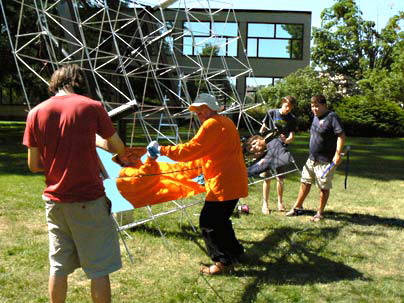Point Focus Thermal Systems
Introduction
Elliot Hallmark provids an interesting cost analysis for a small to medium scale solar furnace which would allow for the regeneration of zinc for energy storage in zinc/air batteries, for the production of calcium carbide and acetylene from locally produced charcoal, and for a wide variety of energy intensive manufacturing processes (working with metal carbides for tools and crucibles, sapphire for optics in high temperatures and pressures, et cetera).
Cost Calculations
Elliot says:
just a quick estimate. Assume a scaffold type frame like doug's MIT concentrator, 3mx3m, with vertical and horizontal supports every .5m (1.5 feet), with a top and bottom layer connected with diagonal pieces so that the thing is rigid.
http://web.mit.edu/newsoffice/2008/s-dish-1-enlarged.jpg (google MIT doug woods for more pictures)
I calculate about 122 linear feet of metal rod needed for that lattice structure, with EMT at 1.99 per 10 feet (call it 9 feet to account for curvature) at the local hardware store here, that's 80 bucks. (labor intensive construction indeed, bending the tubing and all that welding...)
say then that we pay 2 dollars per square foot for mirrors (though doug quotes much less for his project), thats 144 square feet for the system, or 288 dollars for mirrors.
then a whole mess of steel to support the whole thing (doug's looks like its a steel post driven into the ground, encased in concrete), say 300 lbs of steel I beams ( don't know how reasonable that number is) at scrap yard prices (only way i know to estimate) 2 $/lb = $600. another $200 for cogs and chains
thats $1,200 for 8-9 kw, which is linearly scalable within reason (3 or 4 heliostats in parallel, or more built on an appropriately sloped location or into the side you your new 3 story research facility)
so call a 24 Kw get up (within linear scalability, without the need for a tower) $3,600, or $4,000 even.
then a few thousand more for two beefy servos, control electronics, gears and cogs and chains. $8,000 for the whole deal.
What's a reasonable life time on this thing, (before repair costs start to become expensive)? and then multiply 24 kW by number of years * 200 days/yr * 5 hours/day to get total kW/hr energy of the system. (for 20 years, thats 480,000 kWhr, which is fractions of a penny per kWhr). (doug reports a life time of 50 years and counting).
Now, for electricity storage, how about regenerating zinc for zinc/air batteries at those prices? Even at 10 percent total efficiency, or 1 percent (considering carnot has nothing to say about this, that seems achievable, with 80% optical efficiency, 50% crucible efficiency, losses for thermal mass, 50% battery efficiency, etc).
Producing calcium carbide for on demand acetylene would be a way to fortify charcoal (more energy per mol CO2 released) and have an energy dense storage medium for internal combustion engines.
Marcin says:
Ok, now you're talking some numbers.
Your numbers are worth exploring in more detail.
My main concern is replicability of the lattice structure. There may be significant costs involved (as opposed to linear system, which avoid the complexity of 3D geometry). I know that spot welding this together is not going to be the most trivial task. From what we've done on the solar panels - which turned out to be much more work than expected - I predict labor costs for the 3D lattices may easily double your price, and possibly make it a factor of 10 more than you predict. There may be clever ways to build this using some jig, but I don't see that being immediately apparent.
Can you follow up with Doug on the fabrication cost for the lattice?
Yes, 1/5 of a penny per kWhr for a system even if the above cost is 10x what you suggest.
But, it is 2 cents per kWhr of electricity with the 10% overall zinc-air battery cost.
Now, what is the cost of the apparatus for recharging the zinc air battery, and the cost of the zinc air battery itself? You have not considered this at all. Please give me more specifics so we can make a reasonable overall cost prediction range.
If you can provide further details, this may be something that we may be quite interested in evaluating further as a choice for Factor e Farm.
I have a feeling that solar thermal storage for EC engine cars may be a viable option in mobile power, especially where weight is not an issue.
